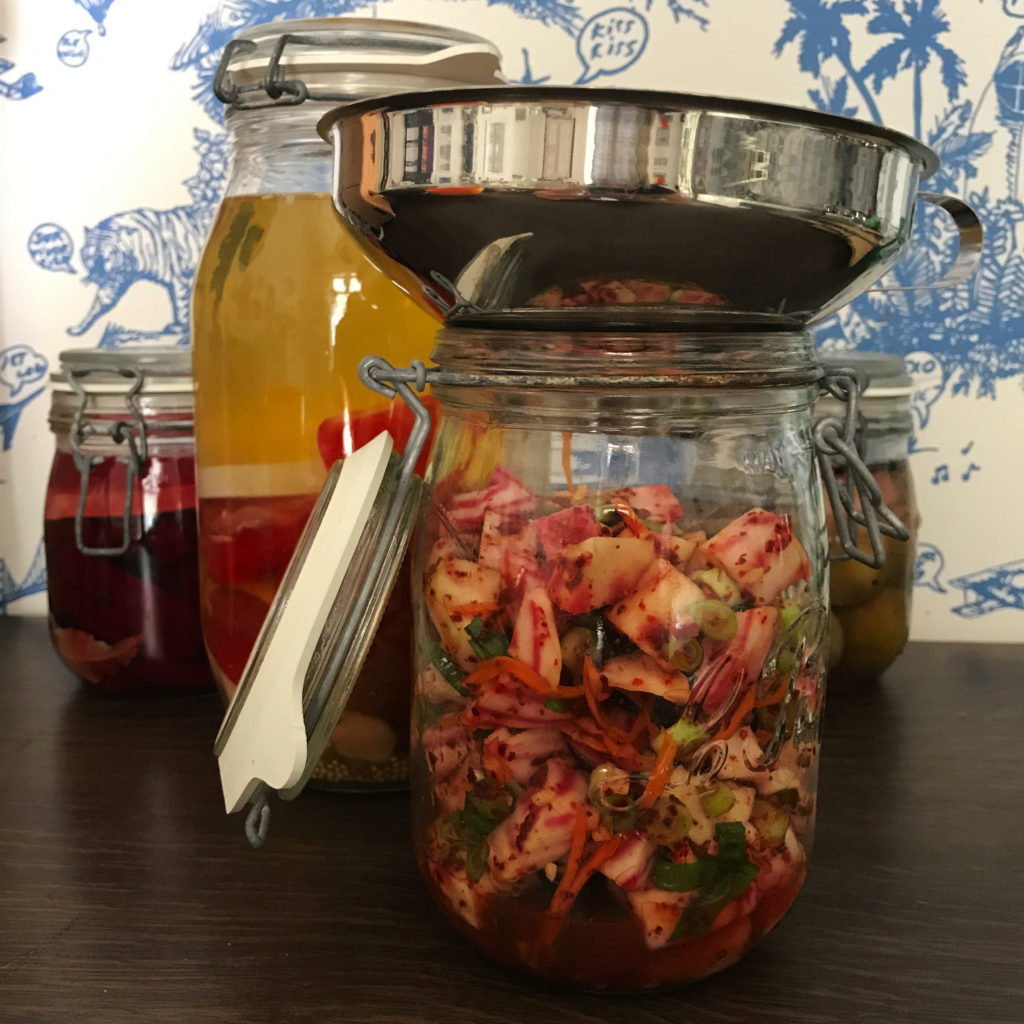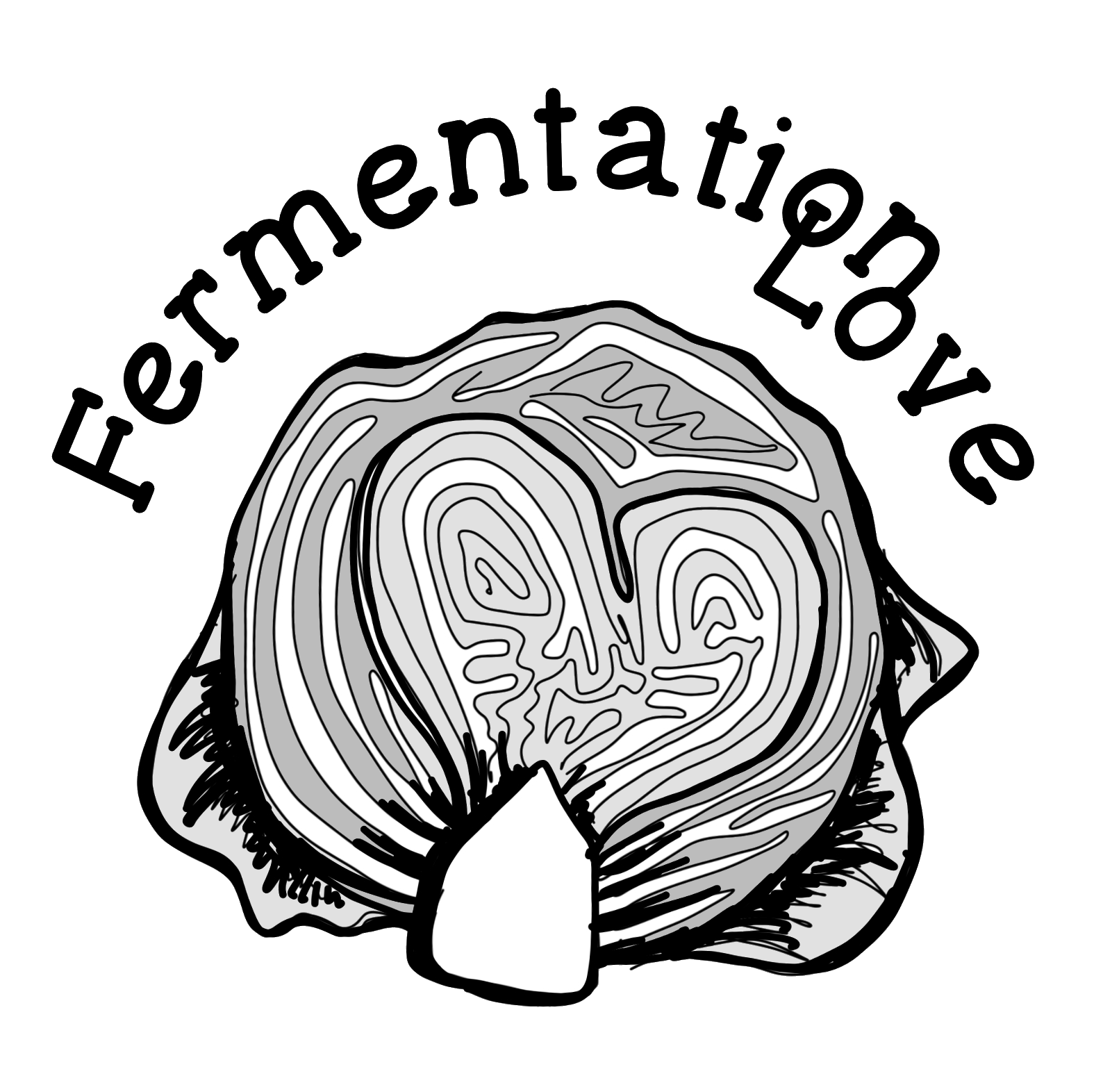I love beetroot! Red beet, yellow beet and candy cane beet. Candy cane beet, also called chioggia, looks so incredibly beautiful that I can't help myself and have to enhance them through fermentation. Fermented beet Kkakdugi Kimchi is almost more beautiful than fermented beetroot - at least visually.
Since Kimchi is similarly high on my list as beet, I tried combining the two. With success! Candy cane beet Kkakdugi Kimchi is really delicious! The earthy sweetness of the great roots goes great with the massive umami of the kimchi paste. And it's nice and spicy too.
For a 0.75 liter jar you need
INGREDIENTS
- 3 candy cane beets
- 1 tbsp. salt
- 1 tbsp. raw cane sugar
- 1 mono garlic or 3 cloves of garlic
- 2 cm of ginger
- ½ carrot
- 2 tbsp. gochugaru (Korean chili flakes)
- 2 scallions (spring onions)
- 1 tbsp. fish sauce
- Water for topping up (approx. 5-6 tbsp.)
For vegans

If you want to make the ferment vegetarian or vegan, you can simply replace the fish sauce with 1 tsp of soy sauce or coconut aminos (tsp instead of tbsp is not a typo, the vegan alternatives are more intense in flavor).
Candy cane beets have the most appropriate flavor for this recipe, but you can also substitute them with yellow or red beets.
By the way, this opens up a delicious experiment: why don't you try making oven vegetables with all three variants of beetroot and find out what differences you can taste. Then you will have gustatory clues as to how the respective beet could work in the ferment.
PREPARATION
Cut the beet into 1-2 cm cubes and cover with the salt and sugar in a bowl. Let stand so that brine is formed. This happens by itself and can take 15-30 minutes.
Meanwhile, finely chop the garlic and ginger. If you can get mono garlic, be sure to use it, it tastes more sweet and gentle than regular garlic. Cut the carrot into fine julienne, the scallions into thin rings.
Once the beets have formed brine, mix with the vegetables, gochugaru and fish sauce (or vegan alternative) and pour into a fliptop jar. To keep the rim clean, use a preserving funnel. If you don't have one, it's not a big deal - then you should wipe the rim of the jar with a clean cloth before sealing.

If necessary, top up with a little water so that the beetroot pieces are just covered. Please do not use brine, the salt and fish sauce are already salty enough. With this ferment, you don't have to worry much about mold, as with all other kimchi variations.
Kimchi is not very prone to mold
By the way: If the kimchi is eaten fresh and ferments for a maximum of 3 days, it doesn't matter if not everything is covered by brine. Then just move the jar a few times a day and keep the vegetables covered that way. The chili powder also creates a good microclimate in the ferment and prevents the formation of mold. With Kimchi, you have the least fear of mold.
The ingredients of many spicy fruits inhibit the growth of bacteria. Perhaps that is why spicy seasoning has become widespread in countries where the growth of bacteria (even undesirable ones) is favored by the prevailing climate.
How long is candy cane beet Kkakdugi Kimchi fermented for?
Ferment for a maximum of 6 weeks, otherwise the beet will become too soft. The first time you can try after 3 weeks, then the beetroots are slightly soft on the outside and inside still very raw crunchy.
Fantastic flavor!

Danke für das Rezept! War gerade auf der Suche nach Info ob es Rettich zur Schimmelvorbeugen wirklich braucht. Ich mag Rettich nicht so . Ich probiere hetzt mal dieses Rezept mit etwas weniger Gochugaru. Sehr scharf mag ich auch nicht so. Ich ziele auf einen süss/sauren mässig scharfen Geschmack hin.
Gerne, liebe Barbara!
Ich hoffe, es gelingt und schmeckt. Meerettich hilft bei offener Fermentation, Schimmel fern zu halten. Wenn Du auf ein anaerobes Milieu Deines Fermentes achtest, brauchst Du solche Hilfsmittel nicht.
Viel Erfolg,
Katsu
Hallo Katsu,
Würdest Du mir bitte verraten was Schluppen sind ?
Bei mir in der Nähe der Schweiz-französischen Grenze sind Schlurben Hausschuhe, und das kann es ja wohl nicht sein.
LG
Martin
Lieber Martin,
Schluppen sind Frühlingszwiebeln, oder auch Lauchzwiebeln genannt.
Viel Spaß beim Fermentieren!
Katsu
Hallo,
das Bügelglas wird aber nicht luftdicht verschlossen, oder? Also der Gummiring im Bild ist nur Deko 😉?
LG Britta
PS: ich habe eine Tüte mit Glasmurmeln oben drauf gelegt, damit das Ferment immer mit Flüssigkeit bedeckt ist.
Hej Britta,
das Glas muss unbedingt mit dem Gummi versehen werden! Fermentation von Gemüse muss anaerob stattfinden, um sicher zu sein. Bitte lies nochmal die Grundlagen nach, damit Du sicher fermentieren kannst und keine gesundheitsschädlichen Produkte produzierst. In aller Kürze habe ich das Wichtigste zusammengefasst: https://fermentation.love/gemuese/gemuese-wild-fermentieren/.
Glasmurmeln kannst Du dann benutzen, wenn sie lebensmittelecht, respektive säuretolerant, sind. Das gilt natürlich noch mehr für die Tüte – Kunststoffe können sich anlösen und unerwünschte Inhaltsstoffe in Dein Ferment freisetzen. Ich empfehle das nicht.
Bitte fermentiere sicher, und bleib’ gesund!
Katsu
Wahnsinnig lecker! Nach vier Wochen schön sauer, aber noch knackig. Werde es demnächst auch mit Kürbis anstatt Ringelbete ausprobieren.
Das freut mich! Gutes Gelingen.
Liebe Katsu,
in meinem Beete und Rettich Kimchi (mit Möhren und Lauchzwiebeln) hat sich am Glasboden, unter der Lake und dem Gemüse, etwas weißliches abgesetzt.
Hast du eine Idee was, das sein könnte?
Viele Grüße und vielen Dank!
Hej Rike, ich denke schon. Schau mal hier https://fermentation.love/fermentation/fermentation-faq/#was_ist_der_weisse_belag_auf_meinem_ferment_und_ist_der_weisse_belag_auf_dem_boden_des_glases_ungesund.
Hallo Rike, braucht es den Zucker zwingend zum Fermentationsprozess? Ich verzichte nämlich gerade zu 100% auf Zucker, und die Alternative die ich dürfte habe ich noch nicht hier, möchte aber die Beete dringend verarbeiten.
Hej Sonja,
der Zucker wird von den Milchsäurebakterien gebraucht, um daraus Milchsäure zu machen. Er wird also transformiert und ist danach nicht mehr als Zucker vorhanden. Die Bete selber enthält ja auch viel Zucker, ohne ihn findet keine Fermentation statt.
Gutes Gelingen!
Katsu
Die Beete sind im Glas.
Nicht ganz klar ist mir, wie lange jetzt alles und vielmehr wo (im Kühlschrank oder bei Zimmertemperatur?) fermentiert wird.
Danke & Gruß!
Mathias
Hej Mathias,
wie im letzen Absatz beschrieben fermentiere ich die Bete 3-6 Wochen. Im Kühlschrank wird der Prozess ausgebremst, das ist für rote Bete nicht nötig. Lass das Glas draußen stehen.
Gutes Gelingen!
Katsu